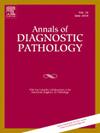The importance of MUC6 immunohistochemistry staining in the histopathologic examination of Crohn's disease: can we enhance our diagnostic power?
IF 1.4
4区 医学
Q3 PATHOLOGY
引用次数: 0
Abstract
Crohn's disease (CD) is a chronic inflammatory bowel disease characterized by transmural inflammation and histopathologic variability, making diagnosis challenging. Pseudopyloric metaplasia (PPM) is a key histological feature of chronicity in CD. However, its identification on hematoxylin & eosin (H&E)-stained slides is subject to interobserver variability. MUC6 immunohistochemistry (IHC) has been suggested as a useful marker for pyloric glands. This study aims to evaluate the diagnostic utility of MUC6 staining in detecting PPM and to assess interobserver agreement compared to H&E staining. In this retrospective study, 38 terminal ileum biopsies from CD patients were analyzed. H&E-stained and MUC6-stained slides were evaluated independently by four pathologists for the presence and gland count of PPM. Intraobserver and interobserver agreements were assessed using Intraclass Correlation Coefficient (ICC). The mean PPM count was significantly higher with MUC6 staining than by H&E alone. Intraobserver agreement between H&E and MUC6 staining was “moderate” (ICC = 0.577, 0.734, 0.738) for three pathologists and “poor” (ICC = 0.439) for one. Interobserver agreement was classified as “good” for H&E slides (ICC = 0.849) and “excellent” for MUC6-stained slides (ICC = 0.993). PPM is an important finding that is not specific for CD but indicates chronic mucosal damage in the gastrointestinal tract. In our study, MUC6 IHC staining in CD improved the detection of PPM and increased interobserver agreement in the detection of PPM. The increase in the number of detectable metaplastic glands in all observers demonstrates the potential of MUC6 staining as a reliable marker. MUC6 IHC may provide a more standardized and objective evaluation, reducing diagnostic variability.

MUC6免疫组化染色在克罗恩病组织病理学检查中的重要性:能否提高其诊断能力?
克罗恩病(CD)是一种慢性炎症性肠病,以跨壁炎症和组织病理学变异性为特征,使诊断具有挑战性。假性幽门化生(PPM)是慢性CD的一个关键组织学特征。伊红(H&;E)染色的载玻片受到观察者之间的差异。MUC6免疫组织化学(IHC)已被认为是幽门腺的有用标志物。本研究旨在评估MUC6染色在检测PPM中的诊断效用,并评估与H&;E染色相比观察者之间的一致性。在这项回顾性研究中,我们分析了38例乳糜泻患者的回肠末端活检。H&; e染色和muc6染色的切片由四位病理学家独立评估PPM的存在和腺体计数。使用类内相关系数(ICC)评估观察者内部和观察者之间的一致性。MUC6染色的平均PPM计数明显高于H&;E单独染色。3名病理学家的H&;E和MUC6染色的观察者内一致性为“中等”(ICC = 0.577, 0.734, 0.738), 1名病理学家的观察者内一致性为“差”(ICC = 0.439)。观察者间一致性对H&;E玻片为“良好”(ICC = 0.849),对muc6染色玻片为“优秀”(ICC = 0.993)。PPM是一个重要的发现,它不是CD所特有的,但表明胃肠道的慢性粘膜损伤。在我们的研究中,MUC6免疫组化染色在CD中改善了PPM的检测,并增加了检测PPM的观察者之间的一致性。在所有观察者中,可检测到的化瘤腺体数量的增加表明MUC6染色可能是一种可靠的标志物。MUC6免疫组化可以提供更标准化和客观的评估,减少诊断的可变性。
本文章由计算机程序翻译,如有差异,请以英文原文为准。
求助全文
约1分钟内获得全文
求助全文
来源期刊
CiteScore
3.90
自引率
5.00%
发文量
149
审稿时长
26 days
期刊介绍:
A peer-reviewed journal devoted to the publication of articles dealing with traditional morphologic studies using standard diagnostic techniques and stressing clinicopathological correlations and scientific observation of relevance to the daily practice of pathology. Special features include pathologic-radiologic correlations and pathologic-cytologic correlations.

 求助内容:
求助内容: 应助结果提醒方式:
应助结果提醒方式:


